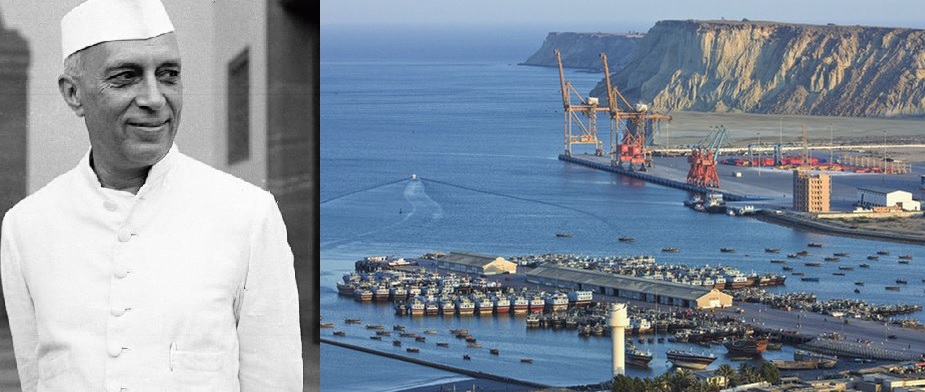Gwadar, Now Pakistan's, was offered to India in 1950s

History News
India
Gwadar, a small coastal town nestled along the Makran coast of Pakistan's Balochistan province, has emerged as a focal point of regional and global geopolitics. Its transformation from a sleepy fishing village to a strategic port city reflects a complex tapestry of history, diplomacy, and missed opportunities. This comprehensive exploration aims to unravel the layers of Gwadar's past, examining its origins, the dynamics of its transfer between powers, and the far-reaching implications of decisions made by key actors on the international stage.
Chapter 1: The Origins of Gwadar
Gwadar's history dates back to ancient times, with evidence of human habitation found in the region dating back thousands of years. Early settlers, drawn to the fertile coastal plains and abundant marine resources, established thriving communities along the coastline. These early settlements laid the foundation for Gwadar's development as a hub of maritime trade and cultural exchange.
The rise of Gwadar as a strategic outpost can be traced to its location along key maritime trade routes, connecting the Arabian Sea to the Persian Gulf and beyond. The town's natural harbor provided shelter for ships traversing the treacherous waters of the Arabian Sea, facilitating trade between the Indian subcontinent, the Middle East, and beyond.
Chapter 2: Gwadar under Omani Rule
In the 18th century, Gwadar came under the rule of the Sultanate of Oman, marking the beginning of a new chapter in its history. The Khan of Kalat, Mir Noori Naseer Khan Baloch, gifted the town to the Sultan of Oman, Sultan bin Ahmad, in 1783. This transfer of ownership cemented Gwadar's position as a key strategic asset for the Omani empire, enabling it to expand its maritime influence in the region.
Under Omani rule, Gwadar flourished as a center of maritime commerce and cultural exchange. The town's strategic location made it an ideal base for Omani naval expeditions and trade ventures, further enhancing its importance in the eyes of regional powers.
Chapter 3: The Offer to India and Nehru's Decision
In the mid-20th century, Gwadar emerged as a point of contention between regional powers, with the Sultanate of Oman offering to sell the town to India. Prime Minister Jawaharlal Nehru was faced with a momentous decision that would shape the course of South Asian geopolitics for decades to come.
Nehru's decision to decline the offer, influenced by strategic considerations and logistical challenges, had far-reaching implications. While some viewed it as a missed opportunity, others saw it as a prudent move to avoid unnecessary conflict and maintain regional stability.
Chapter 4: The Strategic Significance of Gwadar
Gwadar's strategic importance has only grown in the modern era, with its transformation into a major port city and hub of international trade. Situated at the mouth of the Gulf of Oman, Gwadar serves as a gateway to the Arabian Sea and beyond, offering unparalleled access to energy resources and maritime trade routes.
The development of Gwadar as a deepwater port and the integration of the China-Pakistan Economic Corridor (CPEC) have further enhanced its strategic significance. The port's proximity to key shipping lanes and its potential as a hub for transnational infrastructure projects have attracted significant investment from regional and global players.
Chapter 5: Missed Opportunities and Unforeseen Consequences
The decision to decline the offer to acquire Gwadar continues to be a topic of debate among historians, policymakers, and scholars. While some argue that it was a missed opportunity to secure a valuable strategic asset, others contend that it was a prudent decision given the logistical challenges and geopolitical realities of the time.
The consequences of Nehru's decision are difficult to quantify, but it undoubtedly had far-reaching implications for South Asian geopolitics. Gwadar's subsequent transfer to Pakistan and its integration into the CPEC have reshaped regional dynamics, altering the balance of power and influencing the strategic calculus of neighboring countries.
Chapter 6: Balancing Act: Challenges and Opportunities
Navigating the complexities of South Asian geopolitics requires a delicate balancing act between competing interests and strategic imperatives. The challenges and opportunities facing policymakers in the region are manifold, from managing territorial disputes to fostering economic cooperation and regional integration.
Gwadar's emergence as a linchpin of regional connectivity presents both opportunities and challenges for the countries of South Asia and beyond. Balancing competing interests and leveraging Gwadar's potential as a catalyst for peace, prosperity, and stability will require creative thinking, diplomatic finesse, and strategic vision.
Chapter 7: Looking Ahead: Lessons Learned and Paths Forward
As Gwadar continues to evolve as a nexus of regional and global trade, it is essential to reflect on the lessons learned from its past and chart a course for the future. Drawing on historical precedents, strategic analysis, and forward-looking perspectives, policymakers, stakeholders, and scholars can work together to harness Gwadar's potential as a force for positive change in the region.
Conclusion:
Gwadar's journey from obscurity to prominence encapsulates the complexities of South Asian geopolitics and the enduring power of strategic decision-making. As we reflect on its storied past and contemplate its future trajectory, we are reminded of the importance of foresight, diplomacy, and cooperation in shaping the destiny of nations and the course of history. In the years to come, Gwadar will continue to serve as a beacon of hope and opportunity in an ever-changing world.



